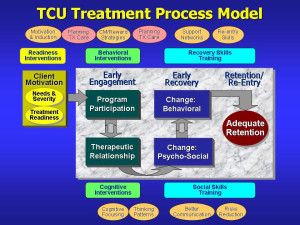The TCU Treatment System includes interrelated assessments and manual-guided interventions that “target” specific client needs and their status in different stages of change during treatment. Evidence for these stages provides the foundation for the TCU Treatment Process Model (Simpson, 2004; 2006) and involves induction into treatment, engagement in treatment, early recovery in treatment, adequate retention before treatment release, and preparation for community reentry.

The TCU assessments provide measurement tools for monitoring client needs and functioning that are essential for evidence-based care planning. Recent adaptations using “automated data capture” technology enhance their clinical utility (see TCU Core Forms below). These revised forms are comprehensive—focused on clients as well as staff training workshops and organizational dynamics—and offer the highest flexibility possible for customizing assessment systems. A set of TCU Interventions that uses an evidence-based visual representation strategy (TCU Mapping Enhanced Counseling) is available, organized logistically according to their typical and strategic applications to the sequence of client needs and progression during treatment. However, they can be integrated into “mix-n-match” combinations or as supplements to other treatment resources. All TCU resources are “copyrighted” in an effort to limit commercial or for-profit applications, but there is no charge to service providers and evaluators for downloading and using them (see Permissions, below).
This section on TCU assessments summarizes major client and program measures related to the TCU Treatment Process Model. Historically, these materials were developed in response to assessment needs of substance abuse treatment clients and programs participating in a series of NIDA-funded grants (DATAR, CETOP, Women with Children, CJ-DATS, and TCOM projects). Treatment settings have included community-based outpatient methadone and drug-free services, prison-based treatment, and intensive residential care. Clients have included men and women, sometimes with children, reporting a wide variety of drug use histories and legal involvement (such as in-prison treatments and diversion programs for parolees or probationers). With modest adaptations, these assessments have been shown to be applicable across diverse settings. As discussed below, they have been designed to be highly focused, practical, and flexible in order to meet the needs of “real-world” programs.
Some forms have been adopted (and adapted) for use in routine practice at a variety of field settings. As core tools in a continuing research program for “improving treatment resources,” however, there have been revisions and refinements made by TCU research staff to some of these assessments to allow especially for “generic” applications across treatment settings. For instance, several instruments have undergone sequential editing in item wording and content over time according to application needs of new projects.
This section of the IBR Web site organizes these assessments according to typical applications. The most recent and highly recommended versions are found under TCU Core Forms. However, the previous (unabridged) versions of these popular forms also are retained for reference, grouped together according to their use in Community Treatment settings and CJ Treatment settings. Furthermore, early research versions of instruments developed for “specialized treatment programs” studied in IBR Projects during the previous decades—that is, Methadone Outpatient, Women and Children, Inhalant Prevention, and Correctional Outpatient/Residential—also have been archived on the IBR Website (including their scoring guides). This allows early adopters of TCU assessments to continue their access to these forms while reviewing potential “instrument upgrades” based on opportunity and judgments about comparative benefits. Collectively, these instruments address special applications such as intake, during-treatment progress, treatment phase tracking, and follow-up interviews. Data included in numerous publications by the TCU research team were obtained using these forms and some have been adapted (in part or in whole) to serve related measurement needs of other treatment researchers and clinicians.